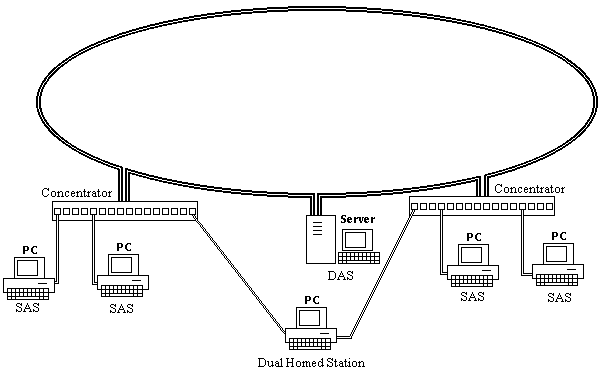
A Made IT project
http://www.made-it.com
info@made-it.com
 |
A Made IT projecthttp://www.made-it.com info@made-it.com |
General
In 1989 the ANSI adopted a standard X3T9.5 which became known as FDDI (Fiber Distributed Data Interface), a 100 Mbps network over fiber. FDDI describes the layers one and two of the OSI model with the connectors used and the characteristics of the fiber cable. In 1994 there was also a copper part adopted into the standard called CDDI (Copper Distributed Data Interface).
FDDI and CDDI both are ring topologies using a token for media access, although star connections through concentrators are possible (compare Token Ring and the use of MAUs).
X3T9.5 defines a token passing ring, dual fiber network. It is designed to be a fault tolerant network. What is called THE ring is actualy a dual ring of which one is used and the other is the 'spare' one.
All connections to the network are made through MIC (Media Interface Connector) connectors for FDDI multi-mode fiber and through ST connectors for single mode fiber. RJ45 connectors are used for CDDI.
| Male | Female | Side |
|---|---|---|
 |
 |
 |
 |
 |
 |
 |
 |
X3T9.5 defines two types of devices:
Stations
Stations are devices that play a real active role, like computers, printers, etc. Stations can de Dual Attached and Single Attached.
Concentrators
Concentrators are devices that make it possible to connect SAS to the network. When a SAS is powered down the concentrator ensures the continuety of the ring by bypassing the port the station is attached to. They function like a hub with a star wired topology. Concentrators are, when connected to the ring, always Dual Attached, DAC (Dual Attached Concentrator).
A DAC has three different types of ports A, B and M. Port A connects the input of the primary ring and the output of the secondary ring and port B connects the output of the primary ring and the input of the secondary ring. The M port connects to the S (slave) port of a SAS.
A SAC (Single Attached Concentrator) has only two different ports: S and M. The M ports connect to SASs and the S port connects to a DAC or another SAC M port.
Dual Attached Stations (DAS)
Stations connected to the ring are always Dual Attached and need to be up and running all the time. DAS have two ports, A and B. Port A connects the input of the primary ring and the output of the secondary ring and port B connects the output of the primary ring and the input of the secondary ring.
DAS can also be connected to concentrators. This way the connection is fault tolerant, but the station need not to be up and running all the time.
Single Attached Stations (SAS)
These devices may not be connected to the dual ring. They only have one port and should always be connected through a concentrator. A SAS has a S-port (Slave) which is connected to the M-port (Master) on the concentrator.
Dual Homing
This means a concentrator or a DAS can be connected to two concentrators. One link will be active, but if that link fails the other one will take over. So actually you create two SAS links. But instead of adding two SAS cards you use a DAS card.

The maximum number of stations is 1000 (500 dual attached stations) with a maximum ring circumference of 100 km.
FDDI and OSI
A complete overview of the OSI layers 1 and 2 for FDDI and CDDI look like this:
| OSI layer 2 | LLC | ||
|---|---|---|---|
| MAC | SMT | ||
| OSI layer 1 | PHY | TP-PHY | |
| PMD | TP-PMD | ||
| Fiber | Copper | ||
The SMT part is a generalThis document is build to describe FDDI. For the CDDI version see the corresponing document. The LLC and MAC descriptions are identical so the only differences will be in the TP-PMD and TP-PHY.
LLC; Logical Link Control
The LLC is identical to IEEE 802.2.
MAC; Medium Access Control
FDDI uses a Token-passing procedure to gain access to the physical medium. Much like Token Ring a station is only allowed to transmit data when it possess the token.
A token is a special frame that runs around the network and a station that has something to send and receives the token removes the token from the network and places it's data instead on the network. The station for which the data is intended copies the data into it's buffers. When the data is back to the sender, that one removes the packet from the network.
A station may only hold the token for a certain amount of time, which is called the Token Holding Time (THT). After that it must stop transmitting data and must release the token just after the last packet send.
When a FDDI network is initialized every station measures the Token Rotation Time (TRT). The MAC protocol limits the maximum token rotation time to a value called the Target Token Rotation Time (TTRT). From this every station calculates the Token Holding Time by the formula:
THT=TTRT-TRT
FDDI also has the possibility to use priorities. First it distinguises data as being Synchronous or Asynchrounous.
Synchronous data is data that is time sensitive like voice and video. When a station captures the token it first sends the the synchronous data.
Asynchronous data can be devided into eight priority catagories. And will be send in importance order after the synchronous data has been send.
PHY
The PHY is responisble for coding and timing of the signals
The actual speed used on a FDDI ring is 125 Mbps, since one control bit is added for every four data bits. That means that the frequency used on the fiber cable is 62.5 MHz, because there is one 1->0 transition per Hz.
PMD; Physical Medium Dependent Interface
The PMD is responsible for the conversion of electrons to light
The first version of the PMD defined multi-mode fiber optic cable with a maximum of 2 km. between two stations. Later a single mode version was added increasing the distance to 40 km.
SMT; Station Management Task
This function comes into action during network initialisation, when generation the token. The SMT monitors the PMD, PHY and MAC functions and is responisble for:
One of it's functions is also to check the optical bypass for switched off stations. It also generates status reports about the network and it's attached stations.
The SMT is a seperate protocol which can be reached through the MAC address of the station and thus the station can me monitored or remotely modified (only the station characteristics according to the network).
CDDI is the copper version of FDDI. Since the differences are only in the PMD and the PHY, this chapter only describes the TP-PMD and TP-PHY.
PHY
The PHY is responisble for coding and timing of the signals
The coding used is a MLT-3 line coding, which is a three-voltage-level encoding scheme.
The transmission of a binary 0 is represented by sending the same voltage that was in the previous bity slot.
The transmission of a binary 1 is represented by changing the voltage in a controlled way from that send in the previous bit slot.
The net effect is that 8% of the signals power is shifted to frequencies below 30MHz, which results in lower attenuation and less cross-talk.
TP-PMD; Twisted Pair PMD
The PMD is responsible for the actual transmission on the cable.
It defines the use of CAT5 cable with a maximum length of 100 m.